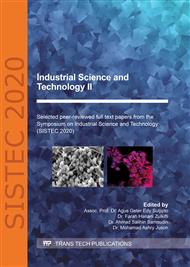p.97
p.104
p.110
p.116
p.122
p.128
p.134
p.141
p.150
Analysis of Volatile Compound from Commercial Swiftlet Aroma Using Solid-Phase Microextraction Gas Chromatography-Mass Spectrometry (SPME-GC-MS)
Abstract:
This study was designed to investigate the compounds in the different types of commercial aroma used to attract swiftlets in the birdhouse. Analysis of the volatile compounds is done on two types of commercial aroma, which is categorized as floor aroma (F1, F2, F3) and top aroma (T1, T2, T3) using SPME-GC-MS. As a result, F1, F2 and F3 shows the presence of major constituents like 2-heptanone (13.53%, 3.22% and 0.37% respectively) and 2-nonanone (0.83%, 2.02%, and 0.82% respectively) using DB-1ms while 2-heptanone (5.87%, 0.78% and 0.45% respectively) and methoxy-phenyl-oxime (11.50%, 11.84% and 0.20% respectively) using DB-wax. Major constituents detected using DB-1ms for T1, T2 and T3 are 1-(2-methoxy-1-methylethoxy)-2-propanol (36.49%, 16.23% and 3.06% respectively). Meanwhile, no similar compounds detected by DB-wax for sample T1, T2 and T3. The overall findings concluded that most of the formulation used in the commercial aroma contained strong odor-producing chemicals to attract swiftlets. More studies should be done on investigating the effects of the commercial aroma towards swiftlet also on aroma made from natural substances instead of chemically produced commercial aroma.
Info:
Periodical:
Pages:
122-127
Citation:
Online since:
March 2021
Keywords:
Price:
Сopyright:
© 2021 Trans Tech Publications Ltd. All Rights Reserved
Share:
Citation:


